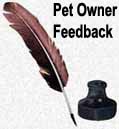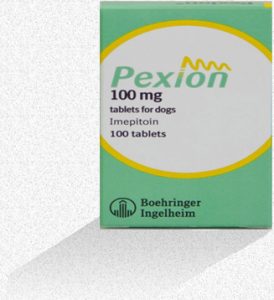Pexion® Imepitoin
Ron Hines DVM PhD

*************************************
One of my European dog-owning clients placed her epileptic pet on Pexion® recently. I had no experience using it and my USA Boehringer Ingelheim representative told me that he knew of no plans to introduce Pexion® to the North American market. That seemed rather unusual to me since the US/Canadian veterinary pharmaceutical market is the most lucrative in the world. It is also ironic because the drug’s anti-epileptic qualities were discovered through NIH-funded studies. Those studies, aimed at developing the medication for human epileptics, were suspended when it was found that the drug affected smokers differently than non-smokers. But dogs (and mice) were used in the testing and the researchers took note that although imepitoin was somewhat less powerful than phenobarbital in its anti-epileptic effects, it seemed to control seizures well in dogs. Pexion® is marketed in Europe for dogs as having less potential to cause side effects than phenobarbital. Studies in Europe confirmed that. When compared to long-term phenobarbital use, Pexion/imepitoin also causes less thyroid gland suppression. Although it did not adequately control seizures in some dogs, the number and severity of seizures in most dogs significantly decreased – particularly as the length of time they were taking Pexion® increased.
*************************************
As I mentioned in a heading note, in December 2018, the FDA approved the use of Pexion® in the United States. But the FDA only approved it for dogs to combat their fear of loud noises like thunder and fireworks (an anxiolytic). Read an article that alludes to the drug’s ability to reduce fear here. Why Boehringer Ingelheim did not attempt to have Pexion® approved in the United States for canine epilepsy I do not know. My guess is that Boehringer’s strategy was that revenues from their product would be greater if it was marketed here for noise-aversion. Many more dogs are afraid of thunder and a multitude of fear-generating situations than those that suffer from epilepsy. Besides, Boehringer needed a product to compete with Zoetis’ SILO® and Purina’s Calming Care®. Neither SILO® nor Calming Care® have applications in dog or cat epilepsy that I am aware of. Another factor that perhaps came into play is the cost of the studies the FDA might requires to gain approval to bring a new canine or feline anti-epileptic drug into the US market. Fulfilling such demands have often been more expensive than the projected sales of the product.
Boehringer sells this medication as scored tablets that are available in 100 and 400 mg sizes, prescribed in portions according to your dog’s weight. It may be sometime before Americans have access to Pexion®. The company’s spokesman did not envision introducing Pexion® in the United States in 2019, mainly as a result of “capacity constraints at the manufacturing site”. But those decisions frequently change depending on the veterinary market demand and profitability. If they sense financial opportunity, they might provide it here earlier. The reverse is also true. A co-author of one of the key imepitoin studies theorized to me that the German studies submitted to the EMA might need to be repeated to obtain FDA approval. It is a common belief that US FDA drug approval standards and demands are the most challenging in the world.
If your dog has aggressive tendencies, please note that a few owners of dogs taking Pexion® reported that their dogs became more aggressive – including growling towards a young child and/or showed a lack of restraint or self-control towards other dogs. I was told that the Pexion® label information that the FDA will require notes that dog owners should carefully observe their dogs for any signs of that during treatment and cease using the product immediately should any signs of aggression be observed.
*************************************
Pexion (imepitoin) was originally called AWD 131 138. It is one of a class of drugs called imidazolones that bind to the same brain receptors as diazepam/Valium®. These drugs are all known to be anxiolytic (calming). So at higher doses or in highly susceptible individual dogs they might change your dog’s behavior in variable ways. The Royal Veterinary College in London looked into that. (read here)
If your epileptic dog was receiving phenobarbital but is now taking Pexion® or if it was the first drug you tried, I would appreciate your observations on how your dog is doing on this medication and any other information you might wish to share with other readers. 
*************************************
October 17, 2018
Hello,
Our 12 year old Chihuahua was introduced to Pexion about 4 years ago and it has been a life saver. He previously suffered 2-3 known seizures per month. Since taking Pexion, he presents with 1-2 mild seizures per year. Our dog goes through regular veterinary check ups and he has not demonstrated any side effects. Phenobarbital therapy would have made him suffer.
We live in Italy and will be relocating to USA soon. We will be bringing a year’s supply with us to assure our dog receives continued care. It is appalling that USA does not support the sale of Pexion.
Sincerely,
K. and K. R. Parents of Maxi
Sent from my iPad
*************************************
March 21, 2017
Hi, tonight we commenced our Radar on Pexion. So far several hours later, it would seem minimal reaction to medication !
Regards,
H.B.
*************************************
February 17, 2017
My dog (17 kg staffy cross) developed idiopathic epilepsy at the age of two and a half. She was on phenobarbitone [phenobarbital] for a couple of years (and remained fit free) with blood tests every six months. Given the possibility of long term liver damage, my vet suggested a change to Pexion. She is now 7 years old and has had no fits on Pexion. (200mg twice daily) She seems to tolerate it well and apart from a little sleepiness (which she also had with the phenobarb) there have been no side effects that I can discern.
I’m not sure why they won’t let dogs have Pexion in the US because the reason my vet changed my dog over from the phenobarb was to reduce any future health problems. And as I said, as far as I can tell, she’s pretty much side effect free, and that’s after being on the Pexion for a bit over a couple of years. For your info, her seizures were cluster fits…the first time it happened she had about five short (relatively mild) fits within around three quarters of an hour. (this was in the middle of the night, and fearing brain tumours and worse, I rushed her to an emergency vet) She was initially treated with Valium until all the various tests were done, ruling out any underlying diseases, and then put on the phenobarb. After about 18 months (after discussing with my vet) we took her off the phenobarb, to see if she might be one of those very few dogs who get over their fits, but within a few days she had more fits, so it was back onto the phenobarb. And then, after some time, on to the Pexion.
Also for your info, in case it’s at all relevant to you, the Pexion costs around $700 (Australian) a year. That’s more expensive than the phenobarb was, but overall only about $100 more per year given that the vet considers it unnecessary at the moment to have the twice yearly blood tests (for liver) that were required on the phenobarb. I hope that’s of some use to you.
C.M , Sydney, Australia
*************************************
June 15, 2016
I’m the owner of Spud, a little silky terrier in Australia. Late last year, at the age of 5, he started having unexplained seizures. They were quite significant seizures and he started with one tremendous one on a very hot day, then went on to have 2 the following week and another 2 the week after that in the same day. He had always been healthy and was a dog with a very big, cheeky and playful personality. When he was diagnosed with epilepsy I was so worried about medication altering his personality that I considered not medicating [him at all] and monitoring him to see how he would cope. But due to the severity of the seizures my vet strongly advised medication as a trial for a few months.Spud started on Pexion. He hasn’t had a seizure since. He gets a little bit dopey for about an hour after it’s been administered, but then he’s back to his usual self.
It’s been brilliant. His liver is great too. I highly recommend this medication. It’s reasonably pricey, but my little Spud is still my little Spud. He’s not doped up and is healthy and seizure free!
K. M.
*************************************
April 9, 2016
I write after reading your website regarding Pexion use. I am a Vet Dr from the UK who recently have started
practicing in Oregon. I am on the lookout for starting to use Pexion, but there seems to be little or no evidence for
FDA pending approval.
I can confirm my previous experience has been by and large positive.
Out of all patients I started on Pexion, about:
1/3rd improved vs pentobarbital
1/3rd remained the same
1/3rd had increased frequencies of relapses into seizure activities.
I really wish this drug would be available as an alternative to the hepatotoxic current market leader.
Kind Regards,
Dr K. S. BVM & S MRCVS, Veterinary Surgeon, Oregon
*************************************
You are on the Vetspace animal health website
Visiting the products that you see displayed on this website help pay the cost of keeping these articles on the Internet.




